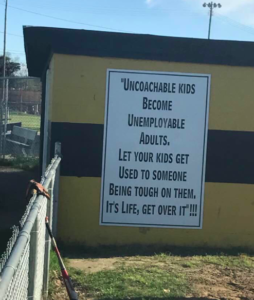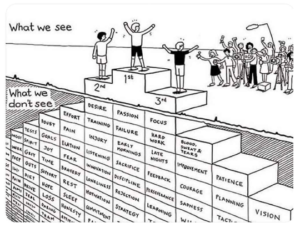Feedback in the Classroom
 “What feedback did you receive today to help you in your learning?” is a power question I recently heard John Hattie ask – one that he asked his own children after school. So I asked my Miss 16. “Nothing” was the continual reply. I was curious…
“What feedback did you receive today to help you in your learning?” is a power question I recently heard John Hattie ask – one that he asked his own children after school. So I asked my Miss 16. “Nothing” was the continual reply. I was curious…
Couple this with a post I saw on social media (right) and it really got me thinking. Are the modern generation uncoachable? How good are we are giving and receiving feedback? What do we as teachers need to do to ensure our students are coachable and can receive feedback?
Speaker Michael McQueen touched on this at a Teachers Matter Conference, remarking that students need to be able to receive feedback in the workplace, to be coachable, to learn the job. He went on to say that the flawed ‘self-esteem’ movement from the 1980’s, the practice of giving everyone a participatory ribbon has made students less likely to strive to be better and therefore less coachable.
Interestingly, my daughter comes home from sports training and 1-1 coaching with specific ‘next steps’ or ‘work ons’ but not from school. Is it a matter of motivation or a difference in philosophy?
Professor John Hattie is very clear in his research – feedback has more impact on student results than any other teaching strategies. Numerous articles and researchers all agree. Great feedback increases motivation, builds on existing knowledge and helps students reflect on what they have learned. What might that look like? Here are some ideas…
Build the Classroom Culture: To ensure students can learn from feedback a strong classroom climate needs to be established. One that values mistakes and focuses on the learning, not merely the product or outcomes. Professor James Pennebaker conveys this in his research, “Both mastery of content and more importantly, the mastery of how to think require trial-and-error learning.” Do your students celebrate making mistakes, or hide them? Is the process important or the product? Do you have conversations about learning? Do your students understand the learning process?
 I wrote about some of this is another article, ‘How do students know they know.’ Unknowingly, schools often glorify the results, not the thinking, mindset, dispositions and hard work that goes on to get to the end product.
I wrote about some of this is another article, ‘How do students know they know.’ Unknowingly, schools often glorify the results, not the thinking, mindset, dispositions and hard work that goes on to get to the end product.
Students need to know not only where they are at, and where they are going, they also are required to understand that each student is on their own learning path, at different stages and therefore avoid comparison, yet support each other on the journey.
The ability to receive feedback, therefore requires students to know that making mistakes, being vulnerable and being OK with the struggle of not knowing is all part of the process.
Give Feedback ASAP: Many studies indicate that the most effective feedback is given immediately rather than a few days, weeks or months later. Focusing on what students did correctly is far more powerful that focusing on what is wrong. Students can become defensive, anxious and blame when what they have done incorrectly is pointed out and this often decreases resilience. Remember to notice extra effort or risk taking.
Use Explicit Criteria and Rubrics: Making assessment criteria explicit helps student to recognise what is important and valued in the curriculum, focus their efforts on key learning outcomes and evaluate their own performance through self-assessment and reflection. Work with students to write clear criteria. Experience shows typically students will actually create more complex and challenging criteria that teachers. Avoid words such as never, sometimes, often and always as these are subjective. Be sure to assist students to understand what success might look like and sound like with clear exemplars and examples.
Empower the Students to Coach Each Other: Explicitly model and teach students how to coach each other to give critique and feedback. This often takes the form of the teacher publicly coaching a student as a model for others and empowering students to do the same in pairs or small groups. If you have not seen the video Austins Butterfly by Ron Berger, please take some time to watch below.
An English teacher I had the pleasure of working with used this model for her Year 10 class. Instead of the students handing in their draft essays for teacher feedback, usually a couple of times before the due date, she asked them to form small groups and taught them how to give feedback using the already established rubrics. Not only did this free up the teachers time to focus on the learning for all, it also impacted the learning in other ways. First, as students referenced the criteria in other student’s work they learned more deeply what the criteria meant and were therefore able to adapt their writing to meet the criteria. Secondly and perhaps surprisingly, peer feedback resulted in no plagiarism. As all students were using the same or similar resources it forced them to use their own words and interpretation. Furthermore, the teachers reported the depth of discussions was far broader and more meaningful than perhaps they might have been if it was a class discussion. Feedback was also given in a more timely manner than the teacher writing individual comments. How might you adapt this for your subject/s?
Gems & Opportunities: This a great way to introduce students to giving feedback given to me by Dr Rich Allen. When a student has shared work, performed or shown their progress, the student then asks for feedback from their peers. The student chooses who gives the feedback receiving 2-3 gems (what they did well) first and then 2-3 opportunities (ways to improve). Empowering the student to choose who gives the feedback keeps them in control of the process and receptive to the responses. After you have facilitated this process a few times, encourage them to choose people who are not in their close circle of friends.
Active Gallery Walk: Invite students to set out their work, drafts or progress around the classroom desks or walls. Give each student 2 sets of coloured post it notes. One colour represents positive feedback and the other questions for the student to consider. Students then walk around viewing and considering their peers work and providing feedback. There are many variations to this – including doing this in small groups, using I Like, I Wonder, Next Steps or a Gallery Run – which is a quicker version.
Other Considerations:
- As your classroom is filled with diverse learners be sensitive to individual needs.
- Avoid comparisons as every student is on their own learning journey.
- Avoid using the word “but”. This may put a student on the defensive.
- Be genuine in your praise. Insincere feedback is easy to detect and can be off putting. Too much can give a sense of low expectations.
- Ask students to give you feedback as the teacher. What are you doing well and how might you improve?
- Use verbs rather than adjectives. For example using the word “rude” will have multiple meanings to different people. However saying, “You raised your voice and used unnecessarily short sentences” provides specific information which can be improved.
- End with clear action points – what do you want the student to do next?
- Focus on the process, not the student’s natural ability.
Tags: feedback, Karen Boyes, Karen Tui Boyes
Published on Friday, November 9th, 2018, under Learning, Teacher Effectiveness

Hi Karen. Great blog on an important issue which underpins student learning. But don’t forget that teachers also should seek feedback from students on their teaching- this underpins their professional development and helps them understand what has worked for which student, and what hasn’t. One of my dynamic teaching tools for this goes like this:
Tool 15: Rank The Teacher Tool
This tool can be a bit daunting for teachers but it is a valuable tool to find out what students think about your classes and how you might improve them.
I like to use class discussion to ask questions such as “What was the best part for you?”, “What part was not so good for you?” or “What could I have done to make it better for you?” then I’ll ask the students to rank my lesson out of 10 where 1 is terrible and 10 is awesome.
As an alternative, I use an anonymous teacher ranking card out of ten with a couple of questions like the questions above. If teachers are life long learners about themselves and their teaching, student learning will also benefit. Regards,
Ian Davies
thanks Ian. Yes I do believe teachers should ask for feedback on their performance as well. Thanks for the ideas.
This is really helpful. Giving feedback with verbs is a clarifying way to think about how to give good feedback to a student.
That’s just fabulous Karen. What every end of year teacher does not want to read now, but it is so practical! I will try again next year! The video is great. Thank you